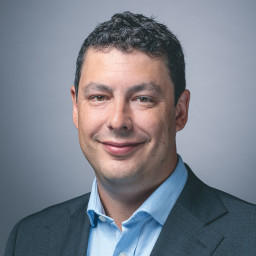Income investors had a tough time in the aftermath of the 2008 global financial crisis. This was a period of slow economic growth and low inflation. The Bank of England's (BoE) base interest rate fell below 1% in March 2009 and stayed there until May 2022.
Low central bank interest rates then led to low bond yields.
It’s true that the yield on UK shares fell less than cash and bond yields between 2009 and 2022. But shares are typically more volatile than bonds.
Recent performance has been led by the “magnificent seven”, seven NASDAQ listed companies expected to benefit from the growth in artificial intelligence. Below is the yield on a portfolio of 55% global equities and 45% global broad market bonds.
A bout of double-digit inflation triggered a reset in yields. It also led to the worst annual return on UK government bonds since 1900. From a peak in May 2020, the market recorded a real loss – adjusted for inflation – of 52%.
Today, the starting point for income investors looks less challenging. The BoE base rate is 5.25%. UK 10-year government bonds yield around 4%. And UK shares currently offer a prospective yield of 3.8%.
Long-term investors should be careful about being overly attracted to the current high yield on cash deposits. We expect the BoE to cut rates as inflation falls back towards target.
So, while we think the one-year savings rate is attractive right now, the rate available once that period finishes could be lower. And we expect government bonds to offer a higher return over the next 10 years, although there are no guarantees. Yields are variable, not guaranteed, nor a reliable indicator of future income.
How is this different for cash, bonds, and shares?
In contrast to cash or bonds, investing in shares brings the potential for income growth. Corporate earnings are expected to grow in line with nominal Gross Domestic Product (GDP) over the long term – and a proportion of these earnings are paid out as dividends.
This economic link offers some shelter against inflation from an income perspective. As prices rise, so do overall corporate earnings. However, high levels of inflation are bad news for total stock and bond returns. That’s because they put downward pressure on valuations.
An income portfolio blending shares and bonds can offer potential for a sustainable income that keeps pace with inflation over the long term. It also has diversification benefits, lowering expected volatility over the long term.
Bonds typically offer shelter in a recession, when share prices have suffered. But shares and bond have sometimes moved in the same way – and both usually suffered when inflation spikes unexpectedly.
Bonds have typically offered a higher yield than shares and a more secure income stream. But shares can offer potential for long-term growth in income and capital. The right mix of both is a key investment decision and as with any investment there are no guarantees.
Share portfolios can be diversified across different countries, industries, and companies. Bonds are issued by governments and companies, in developed and emerging markets, offering fixed-income or inflation-linked payments, and in varying levels of credit quality.
A portfolio invested in a mix of shares and bonds can offer investors opportunities to get a reasonable income, and potential returns to keep in pace with inflation.
One way to achieve this might be through investing in a number of funds that invest in shares and bonds, rather than buying the individual securities. There are also funds available that invest in a combination of shares and bonds on behalf of investors which may suit a portfolio. Below we have a look at 3 fund ideas to consider.
This article isn’t personal advice. Unlike the security offered by cash, investments and any income they produce will rise and fall in value, meaning you could get back less than you invest. If you’re not sure if an investment is right for you, seek advice. Remember, past performance is not a guide to the future.
3 income fund ideas
Investing in these funds isn’t right for everyone. Investors should only invest if the fund’s objectives are aligned with their own, and there’s a specific need for the type of investment being made. Investors should understand the specific risks of a fund before they invest, and make sure any new investment forms part of a diversified portfolio.
For more details on each fund and its risks, you can use the links to their factsheets and key investor information below.
A ready-made mixed asset fund
Investing in a mixed asset fund means you get a lot of diversification from a single investment. It also means you have a professional fund manager changing the amount invested in shares and bonds over time, dependent on what they think are the best opportunities. This means less ongoing portfolio management for the investor.
Baillie Gifford Sustainable Income
Baillie Gifford Sustainable Income is equally split across three broad investment areas – shares, bonds and real assets – property and infrastructure, accessed through listed companies.
The fund aims to increase how much it pays to investors by more than the increase in the consumer prices index (inflation), over the long term.
This means the fund focuses on providing a resilient income over time. While the income provided by this fund might not be the highest, the focus on income across everything it invests in means you can expect it to be more consistent.
This fund is one of Baillie Gifford’s sustainably labelled funds, meaning that Environmental Social and Governance (ESG) considerations are a meaningful part of how they assess investments for it.
The fund invests in emerging markets, high yield bonds and uses derivatives, all of which add risk. The fund takes charges from capital, which can increase the potential income paid, but reduce the potential for capital growth.
We think this fund could be used to provide diversification to a portfolio focused on growth, or be a useful addition to a portfolio focused on income.
Please note that this fund invests in HL shares.
Funds to consider for building your own mixed asset portfolio
If you want more control over your investment risk, you might want to pick individual share and bond funds in proportions that fit your specific investment goals.
One thing to think about is investors need to keep an eye on performance of the funds over time, to make sure they still have the right amount invested in shares and bonds overall. This might mean needing to rebalance your portfolio.
Fidelity Global Dividend
Global equity income funds are a great way to get diversified exposure to shares listed across around the world.
Daniel Roberts is a highly experienced global investor with a focus on providing long-term income and growth while looking to provide shelter in weaker markets. He’s managed Fidelity Global Dividend for over 10 years and developed a strong process looking for quality companies that give sustainable dividends, while being mindful of valuations.
Roberts has the entire global universe to pick from. However, he chooses to invest in companies he believes have more predictable revenue streams and can continue to grow – providing reliable dividends to investors. He favours companies with simple balance sheets, little debt and experienced management teams.
His focus on valuations and income means Roberts invests more in Europe and the UK. This also means he’ll typically have less invested in the US market when compared to a global benchmark.
The fund can invest in smaller companies and derivates, both of which add risk. The fund takes charges from capital, which can increase the potential income paid, but reduce the potential for capital growth.
We think a fund focused on shares offering a higher-than-average dividend yield is a great option to help diversify an investment portfolio focused on generating income.
Artemis Corporate Bond
Investment grade corporate bond funds hold bonds issued by companies at the higher end of the credit quality spectrum. Meaning these are companies that are more likely able to repay their debts to bondholders.
So, they tend to offer lower yields than bonds issued by companies less likely to be able to pay off their debts. While they tend to offer lower yields, prices of these bonds tend to be less volatile over time.
We think a corporate bond fund could be a good addition to a diversified portfolio looking to generate income.
We rate the managers of Artemis Corporate Bond, Stephen Snowden and Grace Le, highly. Snowden’s a seasoned corporate bond investor with over 20 years experience. While Le has less experience, she’s shown herself a highly competent investor so far.
The fund can, and does, invest in some higher yield bonds that have lower credit ratings. This is a higher risk approach than some others. It also has the option to use derivatives, which adds risk where used.
We think it's a great option for portfolios looking to invest in corporate bonds and are prepared to accept a little more volatility for what we see as excellent long-term potential.


